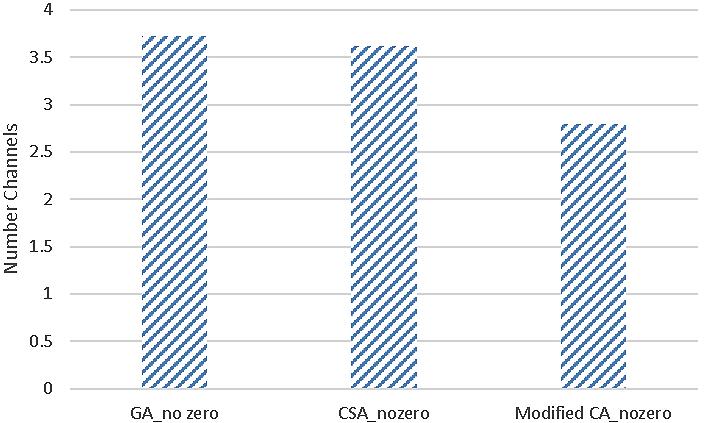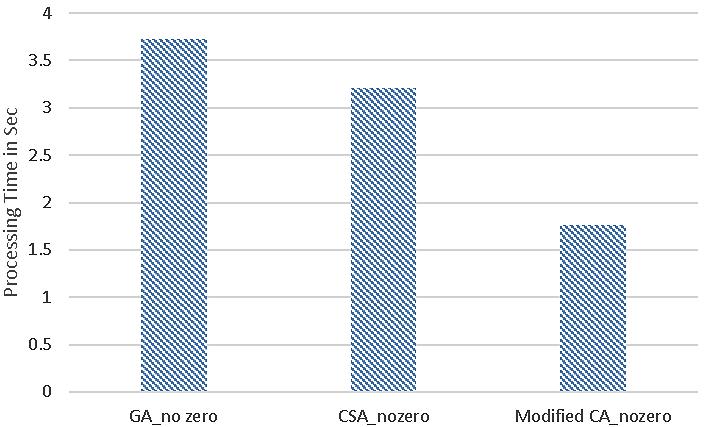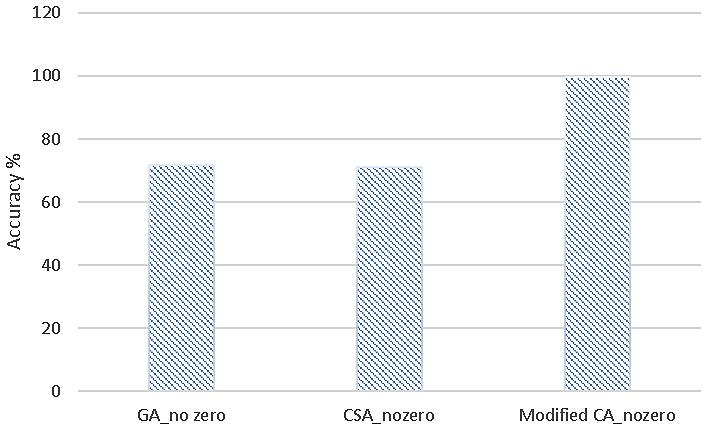
10 minute read
Fast channel selection method using modified camel travelling behavior algorithm
Zaineb M. Alhakeem1 , Ramzy S. Ali2
1Department of Communication Engineering, Iraq University College, Basrah, Iraq
Advertisement
2Department of Electrical Engineering, Universitas of Basrah, Basrah, Iraq
Article Info
Article history:
Received Aug 04, 2021
Revised Feb 06, 2022
Accepted Jun 02, 2022
Keywords:
Brain computer interface
Features extraction methods
Modified camel travelling behavior algorithm
Motor imagery signals
Optimization
ABSTRACT
Brain computer interface (BCI) is a protocol to communicate between the human brain and a device or application using brain signals. These signals translated to useful commands by using features extraction and classification. The most widely used features is the power of alpha and beta rhythms. This type of features gives only 70% of classification accuracy without any extra processing using fixed channels to read the signals. Because the distribution of the power in the brain is not a standard for all people, each one has his own brain power map. A selection algorithm is used to find the best channels that could generate higher power than the fixed ones. Modified camel travelling behavior algorithm is used to select the channels that used to extract the power of alpha and beta bands of motor imagery signals. This algorithm is faster to find the best set of channels, and obtain classification accuracy more than 95% using support vector machine classifier.
This is an open access article under the CC BY-SA license.
Corresponding Author:
Zaineb M. Alhakeem
Department of Communication Engineering, Iraq University College
Basrah, Iraq
Email: zaineb.alhakeem@iuc.edu.iq
1. INTRODUCTION
Brain computer interface (BCI) is a communication protocol between a device and the human brain that will convert the brain signals to useful commands. The BCI systems consists of multiple steps starting from data recording, extracting features, selecting features, ending with classify the features [1], [2]. There are many applications of using electroencephalogram (EEG) signals such as in rehabilitation, communication between a disabled person and other applications [3]–[5] BCI systems still to this moment have problems and limitations, the researchers try to propose solutions to generalize this type of systems. The optimizations algorithms could introduce some solutions in features selection, parameters selection and features extraction methods. Roy et al. [6] used genetic algorithm (GA) to find the optimal path of the robotic arm to reach the destination. Fatourechi et al. [7] used the hybrid genetic algorithm to select the optimum window size of EEG data. In [8], [9] used GA to select the best extracted features set among 36 to create a features vector that will be used to classify motor imagery (MI) signals. Yang et al. [10] used the same algorithm but with electroocography ECoG signal. Gonzalez et al. [11] used particle swarm optimization (PSO) to select the channels that will be used to extract the features of P300 component. Kee et al. [12] used multi-objective GA to select channels for both signals P300 and MI. Ma et al. [13] used PSO in selecting parameters of support vector machine (SVM) classifier to improve the accuracy of MI signal. Liu et al. [14] selects the features in multiclass classification using firefly algorithm, they extract features using common spatial pattern method (CSP) and the local characteristics-scale decomposition method (LCD). They test their proposed method in a maze game. Yacoub et al. [9] used GA to select the more relevant samples in sliding window in to time domain.
Journal homepage: http://telkomnika.uad.ac.id
Noori et al. [15] used GA to select features from functional near-infrared spectroscopy (fNIRS) signals. Nakisa et al. [16] used all the evolutionary algorithms to select the features of EEG signals to recognize emotion of a human begin. Kumar [17] used GA to select the filter order and frequency range to the band-pass filter of preprocessing step of EEG signal.
2. RESEARCH METHOD
The steps of any BCI system are: a) data recording, b) preprocessing methods, c) features extraction, d) features selection, and e) classification process. Some steps are not very necessary in all models such as preprocessing and features selection, that depends on the quality of the data and number of features respectively. The following sections discusses the used data set, features extraction method, features selection method and the classifier.
Thirteen signals recorded from eight healthy people using two different recording devices, which they are g.tec and Neuroscan using five or six recording channels, only five for all the subject that used in this work. The used channels labels are: C3, C4, Cz, Cp3, and Cp4. All the signals have the sampling rate 256 Hz except SubB has sampling rate equals to 250 Hz. These signals are recorded by Dr. Cichocki’s Lab. All of them are recording motor imagery signals of left and right hands. Table 1 shows the details information of each signal. Some subject recorded multiple session in different days. The subject is sitting in front of a computer screen about one meter distance. On the screen an arrow appeared to notify the subject which hand movement should be imagined. A break of two seconds prior to each imagination task. All the subject are informed to avoid blinking and other unwanted movements during the recording sessions [18].
2.2. Features extraction
There are many features extraction methods in literature the simplest one is extracting the power of both alpha and beta rhythms. These rhythms are well known rhythms in MI signals are alpha (8 12) Hz and beta (14 30) Hz. These rhythms are extracted using time-frequency method, discrete wavelet transform (DWT) with (db2). DWT is a suitable tool to extract features from nonstationary signals such as EEG signal [4]. Alpha and beta rhythms are extracted from the details of the fifth and fourth level of the DWT of the original signal as shown in Figure 1. The power of these signals is calculated by squaring the samples then averaging each segment of the signal. Tables and Figures are presented center, as shown below and cited in the manuscript.
2.3. Selection algorithms
Meta-heuristic algorithms give a good solution to select parameters in many applications. In this work the modified CA is used to select the best channels to find the feature from five channels. As the Authors proofed that it is fast and reliable algorithm in low dimensions applications [19]. The following sections discuss some metaheuristic algorithms that used in this paper.
2.4. Genetic algorithm
Genetic algorithm is a well-known algorithm that based on the natural selection with genetics inspired operators. Each chromosome consists of genes (bit) 0 or 1 in binary genetic algorithm. The GA involved three operations: selection, crossover and mutation see Figure 2. This algorithm has six parameters should be tuned [20].
2.5. Crow search algorithm (CSA) [21]
Askazadah proposed a search algorithm that based on the behavior of the crows. Crows have large size brain make them able to remember faces, the places of food after long time, can use tools and can communicate with each other. This algorithm use population of crows to explore the search area. Only two parameters should be tuned (awareness and flight length). At each iteration best solution is found and used directly to find the best hiding place (best position) see Figure 3, the position update is (1).
2.6. Modified camel travelling behavior algorithm (modified CA) [19]
The camel is an animal have the ability to stay without food or water for a longtime in the hot weather. As it is known, the camel travels in group known as caravan. The modified CA based on the behavior of the camel in searching for food and water. The camels distributed randomly when one of the group found a good spot of food, this camel communicate with the others, and the method of communication depends on the visibility of this animal. Visibility and the temperature are parameters affect the camel behavior so they are included into the algorithm. Let us assume that the size of the caravan is ��, and the environment dimension is ��. The camel in location �� given in the (3).
Fast channel selection method using modified camel travelling behavior algorithm (Zaineb M. Alhakeem)
�������� and �������� are the minimum and maximum limits of the location they are belongs to the
The effect of the temperature is given by the (4)
Depending on the visibility value the updating of the location is either as the flowing equation or as the previous one
The flowchart of this algorithm is shown in Figure 4.
2.7. Classification method
SVM is one of the fast, simple classifiers that is used widely in EEG features classification [22]. This method maximized the distance between two hyperplanes that separate the regions of two classes. There are different types of kernels functions: linear and nonlinear depending on the distribution of the features’ points linearly separable and non-separable [4], [23], [24] see Figure 5.
2.8. The proposed method
In our previous work we used GA and CSA to select the best channel to extract power features of EEG signal with a condition to decrease the processing time [25]. Usually in selecting channels and features there is a problem a raised with the random generation of the binary variable, which is generating zero variable in one part of the meta-heuristic algorithm or multiple parts of it. We already solved this problem in our work but the algorithm that we used sill not so fast.
In this work modified CA is used to find the best channels to extract the power ofalpha and beta rhythms. This algorithm is suffer from the probability of generating zero value solution in binary selection that will stop the iterations of the algorithm. To solve this problem a complement of the solution is used to get out of this situation. BCI applications based on finding features to be transmitted to a useful commands, to find the features there must be always a signal to be used to extract these features. When a zero solution generated in metaheuristic algorithms this means there is no channel selected to extract the features whichis not a realistic situation.
When there is no signal used to extract features the system will stop. To prevent this shutdown in the system an easy solution could be used, which is repeat the loop to generate other solution until non zero solution is generated. This solution take time as we proofed in our previous work [25]. Other solution is used in this situation, which is taking the complement of the solution, this works even with applications need more than one bit to be active to keep working see Figure 6, Figure 7, and Figure 8.
The training phase consisted of reading the data, apply the selection algorithm, extract features from the signals of the selected channels then test the classification accuracy. The set of channels that obtain the best classification accuracy is saved to be used in the training phase see Figure 9(a) The testing phases of the system consist of applying the testing data to the best channels set that found in the trining phase, extract the features from this signals and classify them see Figure 9(b).
3. RESULTS AND ANALYSIS
The proposed solution is tested using three metaheuristic algorithms: GA, CSA and modified CA using Matlab 2018a, personal computer of Core i7, 8 GB DDR3 memory and the dataset of thirteen different signals. A comparison among three selection algorithms (GA, CSA and modified CA) is made, all algorithms used the proposed solution. These results are compared with features extraction using all the available channels. Table 2 shows the comparison results modified CA is the superior one with about 99% of classification accuracy. Almost all the samples are recognized to the correct classes. To find the effect of adding the complement of the solution in the selection algorithms on the processing time a comparison is made and the results are shown in Table 3. The processing time is taken as the average of 30 runs of each algorithm and the time is measured in hours. It is found out that in our previous work CSA is better than GA in processing time only. CSA with the no zero condition is faster than GA with the same accuracy of classification. Now the modified CA is better in both classification accuracy and processing time. Table 4 shows a comparison according to the size of features vector that number of selected channels using modified CA is less that all the used other algorithm. The number of channels is an integer number but we take the average of 30 runs.
Table
Fast channel selection method using modified camel travelling behavior algorithm (Zaineb M. Alhakeem)
Decrease number of selected channels will decrease the size of features vector that will be fed to the classifier, this will decrease the processing time. After 30 runs of all the algorithms modified CA is the superior among the other algorithms. Figure 10 to Figure 12 and Table 5 show a full comparison among the three meta heuristic algorithms according to three comparison parameters, processing time, classification accuracy and number of channels.
Table 3. A comparison according to the time consumed in processing 30 runs
Table 4. A comparison among different meta-heuristic algorithm according to the number of channels
Fast channel selection method using modified camel travelling behavior algorithm (Zaineb M. Alhakeem)
4. CONCLUSION
BCI one of the applications that do not accept the absence of the signal even for short time. Always there should be a signal, so features could be extracted and classified. In features selection or channels selection, binary variables are used. Meta heuristic algorithms depends on random generation of variables. Always there is a chance to generate a zero variable. This type of variable is not accepted in BCI systems. In this paper a solution is proposed for this problem. This solution depends on taking the complement of the variable to prevent system shutdown because of the unacceptable variable. The complement is used to make the solution is valid for other application that need more than one bit of the binary variable to operate. The proposed solution is applied on three metaheuristic algorithms which are (GA, CSA and modified CA). The testing results shows that modified CA with no zero variable solution is faster, give shorter variables with highest classification accuracy. In this paper SVM with linear kernel is used as classifier, which is give more than 95% of classification accuracy.
References
[1] P. Diez, “Smart Wheelchairs and Brain-computer Interfaces: Chapter 1-Introduction,” Mobile Assistive Technologies, Academic Press, 2018, pp. 1-21, doi: 10.1016/B978-0-12-812892-3.00001-7.
[2] L. F. N. -Alonso and J. G -Gil, “Brain Computer Interfaces, a Review,” Sensors, vol. 12, no. 2 pp. 1211-1279, 2012, doi: 10.3390/s120201211.
[3] Z. M. Alhakeem and R. S. Ali, “Session to Session Transfer Learning Method Using Independent Component Analysis with Regularized Common Spatial Patterns for EEG-MI Signals,” Iraqi Journal for Electrical and Electronic Engineering, vol. 15, no. 1, pp. 13–27, 2019, doi: 10.37917/ijeee.15.1.2
[4] Z. M. Alhakeem, R. S. Ali, and R. A. A -Alhameed, “Wheelchair Free Hands Navigation Using Robust DWT_AR Features Extraction Method With MuscleBrain Signals,”in IEEE Access, vol.8,pp.64266-64277,2020,doi:10.1109/ACCESS.2020.2984538.
[5] O. George, R. Smith, P. Madiraju, N. Yahyasoltani, and S. I. Ahamed, “Motor Imagery: A Review of Existing Techniques, Challenges and Potentials,” 2021 IEEE 45th Annual Computers, Software, and Applications Conference (COMPSAC), 2021, pp. 1893-1899, doi:10.1109/COMPSAC51774.2021.00286.



[6] R. Roy, M. Mahadevappa, and C. S. Kumar, “Trajectory path planning of EEG controlled robotic Arm using GA,” Procedia Computer Science, vol. 84, pp. 147–151, 2016, doi: 10.1016/j.procs.2016.04.080.
[7] M. Fatourechi, A. Bashashati, R. K. Ward, and G. E. Birch, “A hybrid genetic algorithm approach for improving the performance of the LF-ASD brain computer interface,” Proceedings. (ICASSP '05). IEEE International Conference on Acoustics, Speech, and Signal Processing, 2005, vol. 5, pp. v/345-v/348, doi: 10.1109/ICASSP.2005.1416311.

